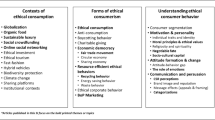Abstract
Export channels into emerging markets differ markedly in channel intensity. This inductive study of 18 British manufacturers and their Chinese intermediaries led to propositions exploring the mechanism behind the marked differences. Findings from the study indicate that low channel intensity may restrict exporting manufacturers' market coverage and expose them to high risks of intermediary opportunism in emerging markets where channel environments are highly uncertain and legal frameworks are weak. However, low channel intensity policy can be an appropriate option when exporting manufacturers face the threats of gray marketing and fake products or when they require heavy intermediary commitments.
Similar content being viewed by others

References
Albaum, G., J. Strandskov, and E. Durr. (1998). International Marketing and Export Management. England: Addison-Wesley.
Anderson, E. and B.A. Weitz. (1992). “The Use of Pledges to Build and Sustain Commitment in Distribution Channels.” Journal of Marketing Research 24(February), 18–34.
Arnold, D. and J. Quelch. (1998). “New Strategies in Emerging Economics.” Sloan Management Review 40(1), 7–20.
Copeland, M. (1923). “Relation of Consumer's Buying Habits to Marketing Methods.” Harvard Business Review 1(March/April), 282–289.
Czinkota, M.R. and I.A. Ronkainen. (2001). International Marketing, 6th edition. Florida: Harcourt, Inc.
Day, S.D. (1994). “The Capabilities of Market-Driven Organizations.” Journal of Marketing 58(October), 37–52.
Dubois, A., L.-E. Gadde, and L.-G. Mattsson. (1994). “Distribution Networks-An Activity Based Approach.” 10th IMP Conference. Groningen, Netherlands.
Eisenhardt, K.M. (1989). “Building Theories from Case Study Research.” Academy of Management Review 14(4), 532–550.
Eriksson, K., J. Johanson, and A. Majkgard. (1997). “Experiential Knowledge and Cost in the Internationalization Process.” Journal of International Business Studies 28(2), 337–360.
Fein, A.J. and E. Anderson. (1997). “Patterns of Credible Commitments: Territory and Brand Selectivity in Industrial Distribution Channels.” Journal of Marketing 61(April), 19–34.
Frazier, G.L. (1999). “Organizing and Managing Channels of Distribution.” Journal of the Academy of Marketing Science 27(2), 226–240.
Frazier, G.L. and W.M. Lassar. (1996). “Determinants of Distribution Intensity.” Journal of Marketing 60(October), 39–51.
Glaser, B. and A. Strauss. (1967). The Discovery of Grounded Theory. Chicago: Aldine.
Heide, J.B. (1994). “Interorganizational Governance in Marketing Channels.” Journal of Marketing 58(January), 71–85.
Heide, J.B. and G. John. (1988). “The Role of Dependence Balancing in Safeguarding Transaction-Specific Assets in Conventional Channels.” Journal of Marketing 52(January), 20–35.
Hoskisson, R., L. Eden, C. Lau, and M. Wright. (2000). “Strategy in Emerging Economics.” Academy of Management Journal 43(3), 249–267.
Johansson, J.K. (2000). Global Marketing, 2nd edition. USA: Irwin McGraw-Hill.
Luo, Y. and M.W. Peng. (1999). “Learning to Compete in a Transition Economy: Experience, Environment and Performance.” Journal of International Business Studies 30(2), 269–296.
Madhok, A. (1996). “Know-How, Experience-and Competition-Related Considerations in Foreign Market Entry: An Exploratory Investigation.” International Business Review 5(4), 339–366.
Morgan, R.M. and S.D. Hunt. (1994). “The Commitment-Trust Theory of Relationship Marketing.” Journal of Marketing 58(July), 20–38.
Nelson, J.M., C. Tilley, and L. Waler. (1998). “Transforming Post-Communist Political Economies: Task Force on Economies in Transition.” National Research Council. Washington, DC: National Academy Press.
Parkhe, A. (1993). “‘Messy’ Research, Methodological Predispositions, and Theory Development in International Joint Ventures.” Academy of Management Review 18(2), 227–268.
Peng, M. (1998). Behind the Success and Failure of US Export Intermediaries: Transactions, Agents, and Resources. Westport, CT and London: Quorum.
Peng, M.W. and A. Ilinitch. (1998). “Export Intermediary Firms: A Note on Export Development Research.” Journal of International Business Studies 29(3), 609–620.
Peng, M.W. and A.S. York. (2001). “Behind Intermediary Performance in Export Trade: Transactions, Agents, and Resources.” Journal of International Business Studies 32(2), 327–346.
Porter, M.E. (1990). The Competitive Advantage of Nations. New York: The Free Press.
Porter, M.E. and M.B. Fuller. (1986). “Coalitions and Global Strategy.” In M.E. Porter (ed.), Competition in Global Industries. Boston: Harvard Business School Press.
Prahalad, C.K. and G. Hamel. (1990). “The Core Competence of the Corporation.” Harvard Business Review 68(3), 79–91.
Ragin, C.C. (1987). The Comparative Method: Moving Beyond Qualitative and Quantitative Strategies. Berkeley: University of California Press.
Rindfleisch, A. and J. Heide. (1997). “Transaction Cost Analysis: Past, Present and Future Applications.” Journal of Marketing 61(October), 30–54.
Shan, W. (1991). “Environmental Risks and Joint Ventures Sharing Arrangements.” Journal of International Business Studies 22(4), 555–578.
Stern, L.W., A.I. El-Ansery, and A.T. Coughlan. (1996). Marketing Channels, 5th edition. Upper Saddle River, NJ: Prentice Hall.
Vernon, R. (1966). “International Investment and International Trade in the Product Cycle.” Quarterly Journal of Economics 80(May), 190–207.
Williamson, O.E. (1985). The Economic Institutions of Capitalism. New York: The Free Press.
Yin, R.K. (1994). Case Study Research: Design and Methods, 2nd edition. Beverly Hills: Sage.
Author information
Authors and Affiliations
Rights and permissions
About this article
Cite this article
Li, L. Determinants of Export Channel Intensity in Emerging Markets: The British Experience in China. Asia Pacific Journal of Management 20, 501–516 (2003). https://doi.org/10.1023/A:1026343126381
Issue Date:
DOI: https://doi.org/10.1023/A:1026343126381



